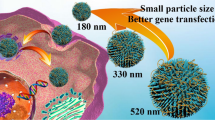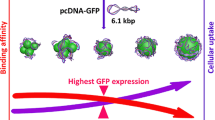Abstract
This article reports on the synthesis and full characterization of innovative silica-based nanoparticle composed of fumed silica as a core decorated with polyethylenimine (PEI) with different molecular weights (25, 10 and 1.8 kDa). Wide range of analytical, spectroscopic, and microscopic methods (TEM, DLS, ζ potential, elemental analysis (EA), TNBS and FTIR) were used to characterize the nanoparticles. Furthermore, transfection efficiency of these nanoparticles as non-viral vector was examined. The silica-PEI conjugates retained both the ability of PEI to fully condense plasmid DNA at low N/P ratios and suitable buffering capacity at the endosomal pH range. PEI-functionalized silica remarkably enhanced EGFP-N1 gene expression in murine neuroblastoma (Neuro-2A) cells up to 38 folds compared to PEI 25 kDa. Meanwhile the results of the cytotoxicity assays indicated that these silica-PEI conjugates have acceptable level of viability.









Similar content being viewed by others
References
Cavazzana-Calvo M, Hacein-Bey S, de Saint Basile G, Gross F, Yvon E, Nusbaum P et al. Gene therapy of human severe combined immunodeficiency (SCID)-X1 disease. Science 2000; 288: 669–672.
Kaplitt MG, Feigin A, Tang C, Fitzsimons HL, Mattis P, Lawlor PA et al. Safety and tolerability of gene therapy with an adeno-associated virus (AAV) borne GAD gene for Parkinson's disease: an open label, phase I trial. Lancet 2007; 369: 2097–2105.
Yang ZR, Wang HF, Zhao J, Peng YY, Wang J, Guinn BA et al. Recent developments in the use of adenoviruses and immunotoxins in cancer gene therapy. Cancer Gene Ther 2007; 14: 599–615.
Bharali DJ, Klejbor I, Stachowiak EK, Dutta P, Roy I, Kaur N et al. Organically modified silica nanoparticles: a non-viral vector for in vivo gene delivery and expression in the brain. P Natl Acad Sci USA 2005; 102: 11539–11544.
Kazemi Oskuee R, Zakeri V, Gholami L, Malaekeh-Nikouei B . Preparation, characterization and transfection efficiency of nanoparticles composed of alkane-modified polyallylamine. Nanomed J 2015; 2: 111–120.
Verm IM, Somia N . Gene therapy - promises, problems and prospects. Nature 1997; 389: 239–242.
Mintzer MA, Simanek EE . Non-viral Vectors for Gene Delivery. Chemical reviews 2008; 109: 259–302.
Buchman YK, Lellouche E, Zigdon S, Bechor M, Michaeli S, Lellouche JP . Silica nanoparticles and polyethyleneimine (PEI)-mediated functionalization: a new method of PEI covalent attachment for siRNA delivery applications. Bioconjug Chem 2013; 24: 2076–2087.
Kneuer C, Sameti M, Bakowsky U, Schiestel T, Schirra H, Schmidt H et al. A non-viral DNA delivery system based on surface modified silica-nanoparticles can efficiently transfect cells in vitro. Bioconjug Chem 2000; 11: 926–932.
Luo D, Saltzman M . Enhancement of transfection by physical concentration of DNA at the cell surface. Nat Biotechnol 2000; 18: 893–895.
Allen TM, Cullis PR . Drug delivery systems: entering the mainstream. Science 2004; 303: 1818–1822.
Sameti M, Bohr G, Ravi Kumar MN, Kneuer C, Bakowsky U, Nacken M et al. Stabilisation by freeze-drying of cationically modified silica nanoparticles for gene delivery. Int J Pharmaceut 2003; 266: 51–60.
Wang L, Zhao W, Tan W . Bioconjugated silica nanoparticles: development and applications. Nano Res 2008; 1: 99–115.
Couleaud P, Morosini V, Frochot C, Richeter S, Raehm L, Durand J et al. Silica-based nanoparticles for photodynamic therapy applications. Nanoscale 2010; 2: 1083–1095.
Kumar R, Roy I, Ohulchanskyy TY, Goswami LN, Bonoiu AC, Bergey EJ et al. Covalently dye-linked, surface-controlled, and bioconjugated organically modified silica nanoparticles as targeted probes for optical imaging. ACS Nano 2008; 2: 449–456.
Dash S, Mishra S, Patel S, Mishra BK . Organically modified silica: synthesis and applications due to its surface interaction with organic molecules. Adv Colloid Interfac 2008; 140: 77–94.
Burns A, Ow H, Wiesner U . Fluorescent core–shell silica nanoparticles: towards ‘Lab on a Particle’ architectures for nanobiotechnology. Chem Soc Rev 2006; 35: 1028–1042.
Cruz JC, Würges K, Kramer M, Pfromm PH, Rezac ME, Czermak P Immobilization of Enzymes on Fumed Silica Nanoparticles for Applications in Nonaqueous Media. In: Wang P (ed).Nanoscale Biocatalysis Methods and Protocols Volume 743,first ed. Humana Press: Boston, 2011, p147–160.
Kar M, Tiwari N, Tiwari M, Lahiri M, Gupta SS . Poly-L-Arginine grafted silica mesoporous nanoparticles for enhanced cellular uptake and their application in DNA delivery and controlled drug release. Part Part Syst Char 2013; 30: 166–179.
Csőgör ZS, Nacken M, Sameti M, Lehr CM, Schmidt M . Modified silica particles for gene delivery. Math Sci Eng C 2003; 23: 93–97.
He XX, Wang K, Tan W, Liu B, Lin X, He C et al. Bioconjugated nanoparticles for DNA protection from cleavage. J Am Chem Soc 2003; 125: 7168–7169.
Kneuer C, Sameti M, Haltner EG, Schiestel T, Schirra H, Schmidt H et al. Silica nanoparticles modified with aminosilanes as carriers for plasmid DNA. Int J Pharmaceut 2000; 196: 257–261.
Ravi Kumar MN, Sameti M, Mohapatra SS, Kong X, Lockey RF, Bakowsky U et al. Cationic silica nanoparticles as gene carriers: synthesis, characterization and transfection efficiency in vitro and in vivo. J Nanosci Nanotechno 2004; 4: 876–881.
Colaco R, Clara Goncalves M, Fortes LM, Goncalves LM, Almeida AJ, Martins BF . Preparation and Chemical Characterization of Eco-friendly ORMOSIL Nanoparticles of Potential Application in DNA Gene Therapy. Curr Nanosci 2013; 9: 168–172.
Cheang TY, Tang B, Xu AW, Chang GQ, Hu ZJ, He WL et al. Promising plasmid DNA vector based on APTES-modified silica nanoparticles. Int J Nanomed 2012; 7: 1061–1067.
Barandeh F, Nguyen PL, Kumar R, Iacobucci GJ, Kuznicki ML, Kosterman A et al. Organically modified silica nanoparticles are biocompatible and can be targeted to neurons in vivo. PLoS One 2012; 7: e29424.
Xiao X, He Q, Huang K . Novel amino-modified silica nanoparticles as efficient vector for hepatocellular carcinoma gene therapy. Med Oncol 2010; 27: 1200–1207.
Zhu SG, Xiang JJ, Li XL, Shen SR, Lu HB, Zhou J et al. Poly(L-lysine)-modified silica nanoparticles for the delivery of antisense oligonucleotides. Biotechnol Appl Bioc 2004; 39: 179–187.
Radu DR, Lai CY, Jeftinija K, Rowe EW, Jeftinija S, Lin VS . A polyamidoamine dendrimer-capped mesoporous silica nanosphere-based gene transfection reagent. J Am Chem Soc 2004; 126: 13216–13217.
Park IY, Kim IY, Yoo MK, Choi YJ, Cho MH, Cho CS . Mannosylated polyethylenimine coupled mesoporous silica nanoparticles for receptor-mediated gene delivery. Int J Pharmaceut 2008; 359: 280–287.
Park JT, Seo JA, Ahn SH, Kim JH, Kang SW . Surface modification of silica nanoparticles with hydrophilic polymers. J Ind Eng Chem 2010; 16: 517–522.
Kell AJ, Barnes ML . Functionalised silica nanoparticles stable in serum-containing medium efficiently deliver siRNA targeting HIV-1 co-receptor CXCR4 in mammalian cells. Int. J. Nano and Biomaterials 2012; 4: 223–242.
He WT, Xue YN, Peng N, Liu WM, Zhuo RX, Huang SW . One-pot preparation of polyethylenimine-silica nanoparticles as serum-resistant gene delivery vectors: Intracellular trafficking and transfection. J Mater Chem 2011; 21: 10496–10503.
Kaur A, Gupta U . Design, Synthesis and Application of SiO2-RATP Nanoparticles for Preconcentration and Separation of Trace Copper Ions: A Green Analytical Method. Adv Nanopart 2012; 1: 1–7.
Snyder SL, Sobocinski PZ . An improved 2,4,6-trinitrobenzenesulfonic acid method for the determination of amines. Anal Biochem 1975; 64: 284–288.
Salmasi Z, Shier WT, Hashemi M, Mahdipour E, Parhiz H, Abnous K et al. Heterocyclic amine-modified polyethylenimine as gene carriers for transfection of mammalian cells. Eur J Pharm Biopharm 2015; 96: 76–88.
Ou M, Xu R, Kim SH, Bull DA, Kim SW . A family of bioreducible poly(disulfide amine)s for gene delivery. Biomaterials 2009; 30: 5804–5814.
Kang HC, Kang HJ, Bae YH . A reducible polycationic gene vector derived from thiolated low molecular weight branched polyethyleneimine linked by 2-iminothiolane. Biomaterials 2011; 32: 1193–1203.
Oskuee RK, Dehshahri A, Shier WT, Ramezani M . Alkylcarboxylate grafting to polyethylenimine: a simple approach to producing a DNA nanocarrier with low toxicity. J Gene Med 2009; 11: 921–932.
Luo D, Saltzman M . Synthetic DNA delivery systems. Nat Biotechnol 2000; 18: 33–37.
Saltzman WM Part II. Fundamentals. Keith EG (ed). North Carolina State University.Drug Delivery Engineering Principles for Drug Therapy,first ed. Oxford University Press: New York, 2001, p23–196.
Acknowledgements
This work was funded by Mashhad University of Medical Sciences and Ferdowsi University of Mashhad, Iran. (Grant number: 3.29767). Financial support from Iran Nanotechnology Initiative council is acknowledged. We would like to gratefully acknowledge Dr Sara Amel Farzad at Pharmaceutical Research Center for her technical assistance.
Author information
Authors and Affiliations
Corresponding authors
Ethics declarations
Competing interests
The authors declare no conflict of interest.
Rights and permissions
About this article
Cite this article
Babaei, M., Eshghi, H., Abnous, K. et al. Promising gene delivery system based on polyethylenimine-modified silica nanoparticles. Cancer Gene Ther 24, 156–164 (2017). https://doi.org/10.1038/cgt.2016.73
Received:
Accepted:
Published:
Issue Date:
DOI: https://doi.org/10.1038/cgt.2016.73
- Springer Nature America, Inc.
This article is cited by
-
Revisiting of Properties and Modified Polyethylenimine-Based Cancer Gene Delivery Systems
Biochemical Genetics (2024)
-
Treatment of breast cancer with autophagy inhibitory microRNAs carried by AGO2-conjugated nanoparticles
Journal of Nanobiotechnology (2020)




